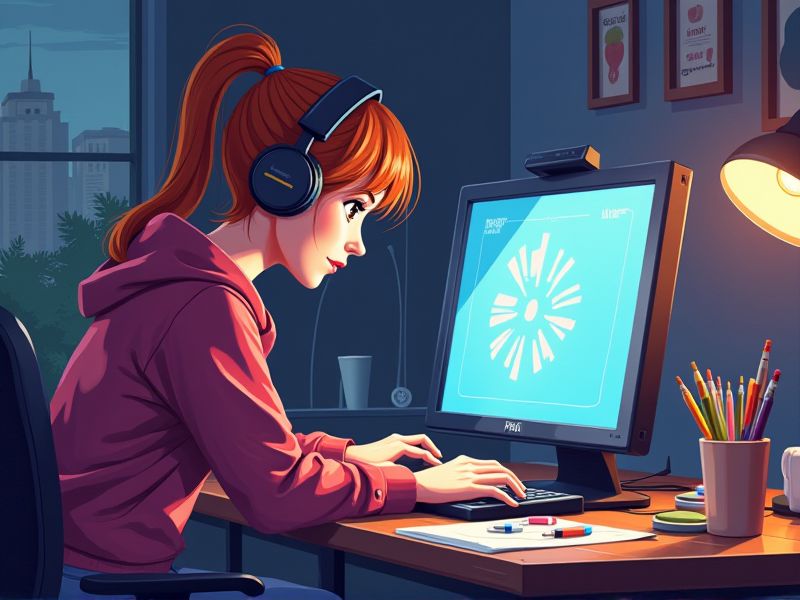
To improve at pixel art, it's crucial to focus on consistency and simplicity, much like the advice to "have no fear of perfection, you'll never reach it" from Salvador Dali, which can be applied by not overcomplicating designs. Consistency in pixel art involves maintaining the same pixel resolution and grid across a project to avoid a disjointed look. Simplifying shapes and details is essential in low-resolution pixel art, where creativity is key to making something look detailed despite the lack of actual detail. By zooming out to view your work from a distance, you can ensure that your pixel art is visually appealing and effective.
How to Be Better at Pixel Art
Master the pixel grid fundamentals
Focus on understanding the pixel grid because every dot you place contributes to a coherent final image. Refining your grid technique leads to consistent, sharper details and reduces visual clutter. Regular practice with grid fundamentals allows you to experiment confidently with color transitions and shading, ensuring a seamless blend across your artwork. Dedicating time to mastering the grid framework directly improves your efficiency and elevates the overall quality of your pixel art.
Use a limited color palette
Using a limited color palette forces focus on contrast and composition, which refines your ability to represent details within pixel constraints. This constraint often leads to creative solutions in shading and outlining that improve the overall legibility of your art. Experimenting with a limited range of hues guides you to understand the visual impact of each tone, emphasizing balance and unity in your design. Over time, working within these constraints can reveal new techniques and efficiencies that elevate your work to a professional level.
Practice dithering techniques
Regular practice with dithering techniques can elevate your pixel art by adding nuanced textures and depth without increasing complexity. Experimenting with different patterns helps create smooth transitions between colors, making gradients appear more natural despite a limited palette. Analyzing the strategies of established pixel artists can provide insights into how varied dithering approaches enhance visual storytelling. With consistent experimentation and data-driven adjustments, your pixel art will achieve a polished, dynamic look that stands out.
Focus on clear silhouettes
Clear silhouettes allow viewers to quickly recognize characters and objects, even in low-resolution pixel art. Focusing on distinct outlines enhances visual clarity and ensures that key details remain identifiable. This approach can reduce visual clutter and improve overall composition in your artwork. Defined shapes paired with a limited color palette can dramatically elevate your pieces, making them more visually appealing and easier to interpret.
Optimize anti-aliasing methods
Experiment with different anti-aliasing techniques and observe how each affects the crispness and clarity of your pixel art. Try selective smoothing on key edges to maintain sharp details while gently blending transition areas. Compare side-by-side iterations of your work to collect data on which adjustments yield the best visual balance. Regularly refine your method by testing small changes in opacity and line weight, ensuring that anti-aliasing enhances appeal without sacrificing style.
Experiment with shading and lighting
Experimenting with shading and lighting can transform flat pixel art into a dynamic representation of depth and form. Adjusting light source placement and shadow contrast introduces a layer of realism that communicates texture and dimension. Consistently practicing various techniques helps you understand how different color intensities and gradients interact to create the illusion of movement and space. This data-driven approach to controlled light distribution and pixel contrast can significantly enhance the overall visual impact of your work.
Analyze classic pixel art examples
Analyze renowned classic pixel art to observe how each pixel placement contributes to recognizable forms, which informs your own composition decisions. Reviewing historical works highlights effective color palette restrictions and contrast management that directly improve clarity and perception in your art. Examining nuanced lighting techniques and dithering methods reveals strategies for conveying depth within a limited resolution. Comparing your creations with these established examples drives iterative refinement, ensuring that data-informed adjustments continuously elevate your skillset.
Iterate through feedback
Start by sharing your pixel art pieces with a community to gather a variety of feedback based on technical details and creative vision. Use each comment as a data point to evaluate what color choices, shading, or detailing could be refined further. Iterate your revisions through multiple cycles of critique and improvement, ensuring that each update is informed by clear, measurable feedback. Finally, consistently compare your newer iterations with previous versions to track progress and identify patterns in your growth.
Create thumbnails before detailed work
Start by sketching small thumbnails because they allow rapid exploration of different compositions without investing too much time in details. This method minimizes errors by highlighting potential layout issues before you commit to a detailed design. Testing multiple thumbnails lets you quickly isolate the most effective visuals, saving time and channeling effort where it matters. Once you choose the best thumbnail, transferring its core layout to a detailed project becomes a more focused, data-driven process.
Commit to regular practice
Pixel art requires commitment and regular practice to strengthen your eye for pixel-level detail. Consistent practice enables you to better understand color palettes, shading techniques, and how to create depth with minimal pixels. By dedicating time each day or week to small, focused projects, you'll quickly spot areas for improvement and witness your skills evolve. Over time, this disciplined approach transforms your creative process, ultimately elevating your artwork to a more refined and professional level.
Summary
Understanding pixel grid fundamentals ensures every element of your work is precisely placed, minimizing unwanted artifacts and enhancing clarity. Embracing a limited color palette forces careful decisions, resulting in more focused and visually consistent compositions. Practicing dithering techniques allows for subtle gradients and texture, effectively simulating a broader range of shades and adding depth. These core strategies combine to elevate your pixel art, ensuring that precision and creativity work hand-in-hand for impressive results.
